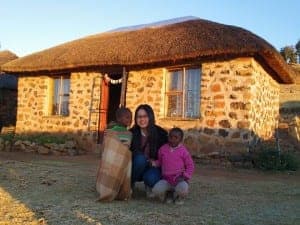
On the very first week that I started on the Product Development team, I was immediately absorbed into a myriad of projects around the world, from Mexico, Tanzania, India, Morocco to China. Every day, microfinance jargon like “microcredit, microloans, individual loans, microinsurance, mobile banking” swam around in my head. I felt I was learning a new language.
Women’s World Banking is unlike any other organization I’ve interned at or seen before. It is a non-profit devoted to a social purpose but achieves its goals through developing the business case for its cause: women’s financial security. It is based in New York but operates globally, stringing together its network members, not by obligation, but a shared vision that one day, all women would have access to financial services.
Lost as I was, I had the first of my many “aha” moments at Women’s World Banking after seeing the TEDx talk on “ Filling the Void” given by Mary Ellen Iskenderian, the CEO of Women’s World Banking.
Aha moment #1—“There is nothing micro about one billion women”.
Rather than depicting them as a charity case, Mary Ellen presented these one billion unbanked women as a powerful, productive, and creative force indispensable to our economy. I was immediately pulled into this vision. Having been educated at Bryn Mawr College, an institution with a strong focus on women empowerment and an emphasis on international development, I believed firmly that alleviation of poverty relies on empowering individuals. By giving low-income women, who are traditionally excluded from the formal banking sector, the tools to save and build businesses, they could improve their lives and the lives of their families instead of just relying on monetary aid for survival.
Aha moment #2—microfinance is a fitted tool that involves different products depending on the local contexts in which it is used in.
One of my first projects was summarizing the in-field research findings about mobile banking in Tanzania. As I pored over pages of interview notes about how people used mobile phones to save, deposit, and transfer cash, I realized how important local contexts is in meeting people’s financial needs.
Providing the financial tools that fit different needs require a thorough understanding of the lives and culture of the people who live in that part of the world, places that often lack access to many of the things that we take for granted (infrastructure, roads, water, etc). It was then that I understood why many of the staff on the product development team are in the field performing rigorous research, organizing focus groups, and conducting interviews to understand their customers. Rather than designing a one-size-fits-all guide for their clients to follow, they take their latest learnings from the field to synthesize and design the tools that would best meet the unique demands of that specific market. In Nigeria, Malawi, and Tanzania, for instance, Women’s World Banking along with their partners are reaching underserved segments by developing saving products and delivery channels that meet the needs of low-income women. In India, their research about the potential of youth savers led to the design of a youth saving product for daughters of existing clients of SEWA bank to deposit their pocket money into a bank account.
Aha moment #3—Financial Inclusion has a social impact that goes beyond just addressing poverty alone
Until this day, I could not forget the face of the eleven-year-old girl from the Dominican Republic whom I had met during an internship at a district attorney’s office. Helpless and poor, she was goaded into performing a sexual act for her biological grandfather in exchange for pocket money. I thought naively that if perhaps she had some financial education and a bank account, she would have saved enough to leave her grandfather sooner and get out of the life she was in. I was wrong, however.
At Women’s World Banking, I learned that the problems she faced—poverty and sexual violence—were much more complex and could not be solved by a bank account alone. She will need a lot more support from the society such as social security, counseling, and legal protection. Nevertheless, having financial access is critical because it provides a basic security net for those who are financially vulnerable to survive shocks we all experience like health emergencies. Most importantly, access to financial services will create a buffer for her against violence and build her capacity to become independent: a 2007 study on the Intervention with Microfinance for AIDS and Gender Equity found that economic and social empowerment of women lead to reductions in intimate partner in violence. In fact, Women’s World Banking is currently conducting a research study in Colombia about the impact of having a savings account for women who experience intimate partner violence.
My experience at Women’s World Banking is lot like a mouse finding its way through a maze. Every now and then, I become lost in the different regions and projects in which I am involved, only to find a new path to go on. It’s challenging, puzzling, but all the more exciting. This is due partially to the “aha!” moments that happen on a random afternoon and the inspiring people I’m surrounded by. But most importantly I feel captivated by the strong social message found in our work, from products to advertising campaigns, that tells an industry with skewed perceptions of the poor that the financial system is meant to be inclusive and the productive force of women around the world should be cherished.



